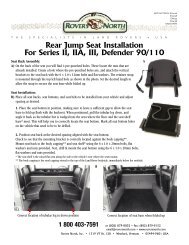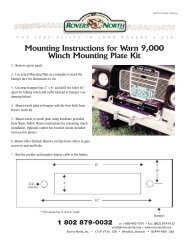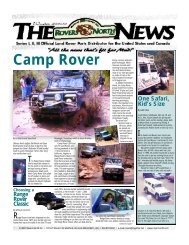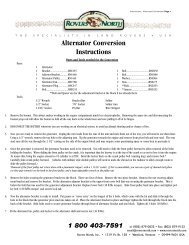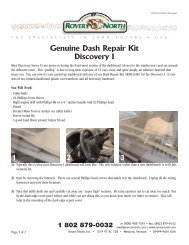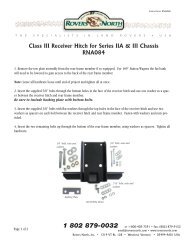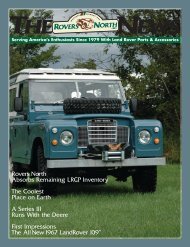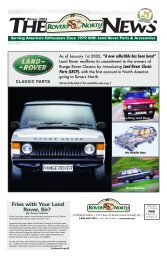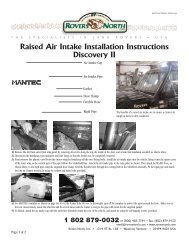You also want an ePaper? Increase the reach of your titles
YUMPU automatically turns print PDFs into web optimized ePapers that Google loves.
electronic throttle. By going to drive-bywire,<br />
Land Rover engineers allowed the<br />
traction control system to control power<br />
output in marginal situations.<br />
In addition to backing off the gas to<br />
prevent wheel spin, the Terrain Response<br />
program reduces the speed at which the<br />
vehicle responds to the throttle. When the<br />
ground is slippery, everything has to be<br />
gentler to keep the wheels from spinning. A<br />
quick jab of the gas pedal will produce a<br />
snappy takeoff on pavement, but it will just<br />
dig a hole in packed snow. Terrain<br />
Response compensates for overenthusiastic<br />
drivers with very gentle acceleration in<br />
deep snow or mud. That response<br />
modulation is the first feature that sets<br />
Terrain Response apart from traction<br />
control in other brands.<br />
If the wheels continue to slip, the<br />
Terrain Response has yet another trick up<br />
its sleeve. <strong>The</strong> new Rovers use computer<br />
controlled air suspension. Now, that<br />
system is also called upon to increase<br />
traction. <strong>The</strong>y achieve that by sending more<br />
pressure to the air springs at corners that<br />
are slipping. That presses the slipping<br />
wheels more firmly into the ground and<br />
helps the vehicle maintain its footing.<br />
It’s the computerized equivalent of piling a<br />
few guys on the back bumper to give<br />
slipping wheels traction.<br />
In addition, if the wheel is slipping<br />
because it’s in a deep rut, the system can<br />
shove the tire down several inches to find<br />
firm ground. When that happens, the<br />
computer knows to raise the whole vehicle<br />
to keep it clear of rough ground later, and<br />
it does that automatically.<br />
As soon as the truck has good traction<br />
on level ground, all systems return to their<br />
normal modes. <strong>The</strong> whole thing is actually<br />
invisible to the driver, except for the<br />
results, which are remarkable. Last winter,<br />
I took my own Sport and my old ex-NATO<br />
‘91 Defender into a snow covered meadow<br />
to compare traction. <strong>The</strong> Sport had stock<br />
Continental all-season tires. <strong>The</strong> Defender<br />
had Michelin XZL military tires, one of the<br />
gold standards of off roaders. <strong>The</strong> result?<br />
When it came to traction, electronics<br />
allowed the Sport to easily outperform the<br />
Defender.<br />
I was surprised, but the results spoke<br />
for themselves. <strong>The</strong> new Sport’s traction is<br />
impressive by any standard. Of course, the<br />
Defender still has the edge with skid plates,<br />
tire chains and a winch, but that wasn’t the<br />
purpose of this particular comparison.<br />
And you could always fit those things to a<br />
Sport if you were so inclined. In fact,<br />
I’m looking forward to the day a Sport<br />
enthusiast brings one to our shop for some<br />
serious off-road customization. I think the<br />
result will be very impressive.<br />
When the ground gets rough, the<br />
Terrain Response does even more.<br />
It modulates the throttle and the transmission<br />
to get up hills, and then it uses the<br />
brakes to automatically keep the vehicle<br />
from running away on the downgrades. It’s<br />
a little surprising the first time you experience<br />
it, as it chatters away, but there is no<br />
doubting the effectiveness of the system.<br />
All this interplay between suspension,<br />
engine, transmission, and brakes couldn’t<br />
take place without a sophisticated<br />
computer network. In a Rover, they call<br />
that network the CAN bus, short for<br />
Controller Area Network. CAN allows all<br />
the different computers in the car to share<br />
and exchange data, and it allows them so<br />
spread tasks across multiple systems.<br />
If Rover were to combine the electronic<br />
finesse of today’s Sport with the mechanical<br />
brute-force capability of the Defender,<br />
the result would be impressive indeed. <strong>The</strong><br />
obvious question is – why don’t they do<br />
that? I believe the answer is twofold:<br />
ruggedness and serviceability.<br />
<strong>The</strong> electronics are great when they<br />
work, but you need fragile and expensive<br />
electronic testers to service the systems.<br />
That’s a problem in much of the world.<br />
<strong>The</strong>re is also the issue of training service<br />
personnel to fix the electronic systems. In<br />
addition, the simple mechanical systems<br />
Land Rover built their name on are more<br />
rugged when there’s constant exposure to<br />
off road conditions. <strong>The</strong> electronics are<br />
great, though, for anyone who off-roads<br />
occasionally.<br />
(For more information, check out<br />
www.robisonservice.com or<br />
http:// jerobison.blogspot.com)<br />
P<br />
15



